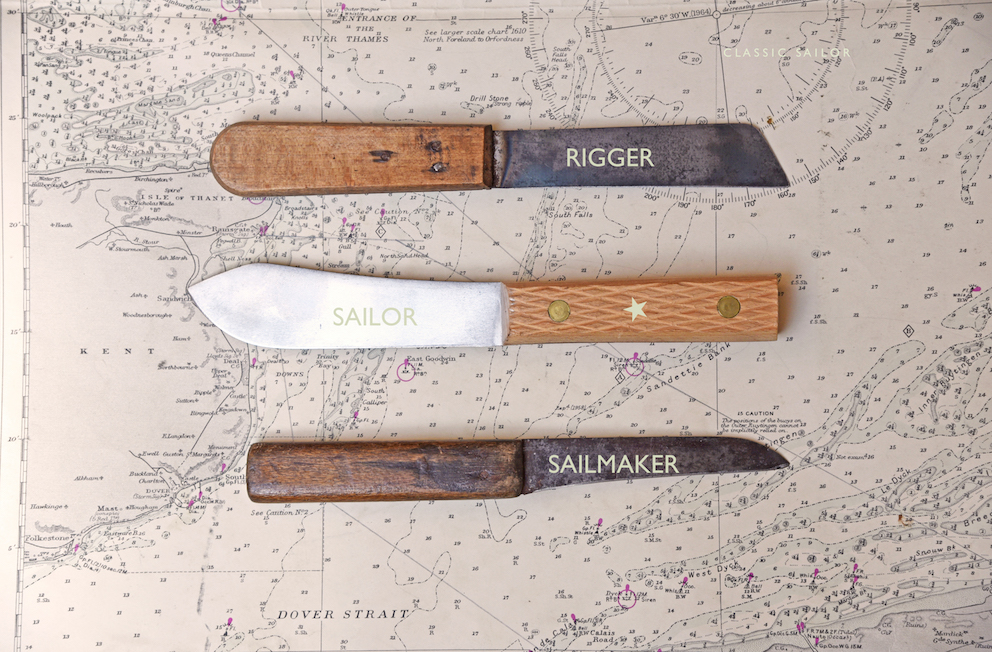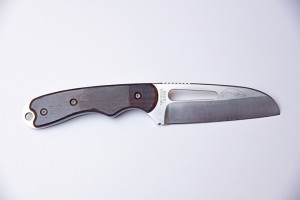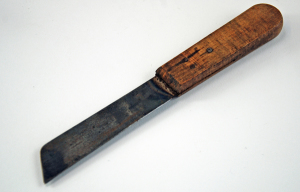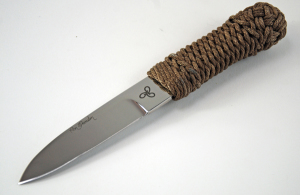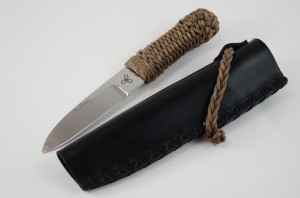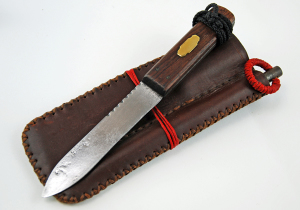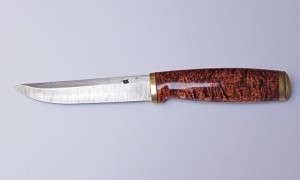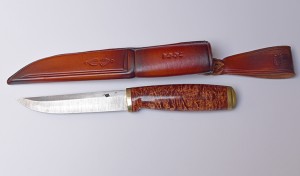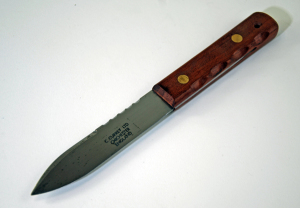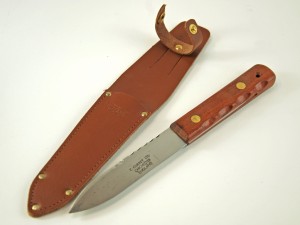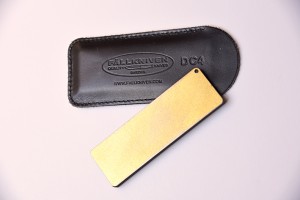Safety knives for sailors – a review by Guy Venables and Dan Houston
The simple sheath knife has always been the most important piece of personal kit a sailor can have. Aside from general cutting and chopping, it can also save limbs and lives. Two of our team have witnessed the gory reality of fingers caught in a block or winch: in one circumstance, two fingers were lost while people struggled to open their multi-tools, in the other the person was saved by the single movement of a sharp and accessible sheath knife.
Practicalities aside, and being one of mankind’s oldest tools, when it’s well made, the sheath knife can also be the most satisfyingly tactile object that one can handle and use.
As always, there’s a bewildering array of choice on offer so for the moment we’re concentrating on general purpose, fixed-blade sheath knives that we feel may have an advantage over some of the others, taking into account everything from price and function to aesthetics. We’ll leave out the Japanese folded steel and Damascus blades, for instance, as they are just too ornate and expensive to feel practical on a boat. We have also left serrated blades for another time, partly because the sharpening process is rather different. Here are a few that we either own or wish we did.
The image above shows three types of knife you might have found on an old schooner – the square tipped rigger’s knife, semi-blunted sailor’s knife
and the pointed sailmaker’s. In his book of knots Clifford Ashley says: “The sailmaker’s knife is pointed and the back is often used in rubbing light seams.
The sailor’s work obliges him to be both sailmaker and rigger and his knife frequently has a blunt point.
In addition to his professional uses it is often the sailor’s only eating utensil – his fingers serving as boosters.
On long voyages the cautious shipmaster will lead the whole crew aft to the carpenter’s vice
and have the point of each knife snapped off to resemble the rigger’s knife.”
Below the reviews is some advice on how to maintain and sharpen your sheath knife. See also our FOLDING KNIVES review.
J ADAMS TWO PIECE YACHTSMAN’S SET
This is really good no-nonsense rigging knife made by the Jack Adams firm in Sheffield. It’s the two piece yachtsman’s leather-sheathed set with a 3mm-backed stainless blade that you can lay a hammer onto if you need to chop a heavy hawser. It’s well made in that trustworthy bullet-proof way with a full tang and comfy rosewood scales with three brass rivets. It has a lanyard hole and sits in the sheath about halfway up the handle – so it’s nice and secure. The shackle key-spike combo feels good and strong in the hand too.
£40.20 www.sheffieldknives.co.uk
MYERCHIN GEN 2 OFFSHORE
Tested at sea is the epithet for these knives and they are virtually the perfect knife on a boat. The massively strong pro-marine stainless full tang sheepsfoot blade is some 4mm thick on the back meaning its integral shackle key is really useful and effective due to the huge leverage you can get from the handle. The handle is made with warm rosewood scales carved to fit snugly in a tight fist. And yes it has a lanyard hole so you won’t lose it. The knife’s deep profile does well will rope and can be sharpened up to slice cleanly through the edge of paper. The sheath is made from tough leather with a marlinspike secondary sheath stitched over the top to hold the stainless and the slightly curved marlinspike – with its own shackle key… It works like a rigger’s dream. It’s so well made it feels like it will probably last forever. £89.23, www.myerchin.com
DEXTER RUSSELL GREEN RIVER 4.5 INCH SHEATH KNIFE
This is the legendary knife espoused by trappers and mountain men of the American East and West, and made for nearly 200 years now by Dexter-Russell in in Southbridge, Massachusetts. It’s a simple design with a high carbon steel full tang blade, double brass-riveted through diamond-etched beechwood scales. It’s not a big knife, with a 4.5in blade that is 2mm thick on the back. But the blade is very versatile having a degree of flexibility while being stiff enough to clout with a hammer if needs must. You can get these super-sharp and they hold their edge really well; just remember to oil it for the off season. They don’t come with a sheath so you probably need to make one. And they are quite hard to come by since ebay stopped allowing knife sales. We found them at Nantahala Trading in the USA selling at £13.80 but then with a whopping £31 shipping bill… (Equals £45-ish). So they are a utility item in the States but have become a bit specialist over here. nantahalatradingpost.com
HELLE HELLEFISK
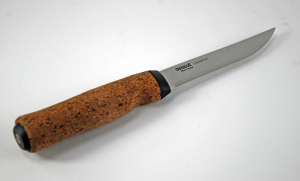
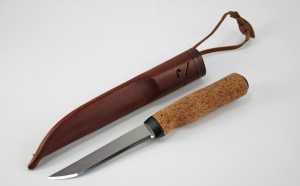
Helle knives, known for lasting for generations, are seen as a traditional Norwegian family heirloom. To look, feel and touch one of Helle’s products is to witness true craftsmanship – each knife and sheath is subject to 45 separate manual operations using stone, horn, bog-aged wood, leather and, in this case, cork for the handles (at 64g this one floats). The 123mm blade, in the puukko tradition, is made from Helle’s unique triple-laminated Stainless Sandvik 12C27 steel. All come with a lifetime warranty. £64.95 inc P&P. For best price, go to www.alloutdoor.co.uk www.helle.no
SHOE KNIFE – BROAD POINT
We are big fans of the utility or cobbler’s knife, especially with the broader, more seamanlike point, as shown here. It is made of carbon steel, will bend enough to be used as a scraper, and will get you out of trouble. It will keep a sharp edge as it’s designed for cutting leather, and although it comes without a sheath, maybe this is your chance to work on your leather stitching.
The only really truly disposable ‘anything goes’ knife here. Available in varying blade lengths, from 4in-6in (102mm-152mm). From £4.60, www.sheffieldknives.co.uk
BOYE COBALT BASIC 3
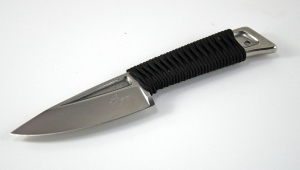
This is arguably the most practical boat knife on the market. It’s made from a mixture of cobalt, chrome, nickel, tungsten, silicon, iron and carbon (ie, no steel), which means it’s impervious to saltwater corrosion. At the cutting edge, the carbide crystals produce micro-serrations for supreme cutting and the crystals keep the edge intact. The whole knife is 8in long with the blade being 4in (101mm) 0f that. And at Boye they don’t bother with scales using instead seven foot of strong cord, which actually feels really good in the hand. It comes with a black Kydex-lined pouch sheath. It is also the only knife here with a sharpening-angle guide on the finger guard for precise honing. Available with a pointed or blunted tip. £217 plus P&P, www.boyeknives.com
NEPTUNIA PEN SKOULM CUSTOM
With a French sennit handle, knotted by internationally renowned rigger Patrick Moreau, this lovely hand-forged knife is frankly a little over the top for our selection. But it’s here because it’s a true work of art. The full tang blade is made with tough 12C27 stainless steel, it has an antioxidation treatment, and the steel hardness is rated at 58HRC, so it has a durable sharp edge. It has an open bottomed leather sheath Neptunia is famed in France for its innovative designs and high quality of workmanship – and this knife is the perfect example. It’s not cheap though, so maybe one for the owner rather than general use by the crew. £515 www.neptunia.fr
GREEN RIVER
Made famous by the Dexter-Russell Green River works company this is what most of us think of as the Green River style of knife, though technically this is the so called Dadley style, with a spear point blade (see above). But it’s also traditionally the sailor’s safety knife of choice, as made here in the UK by Arthur Wright & Son in Sheffield, complete with a steel and deep leather sheath. The Wrightversion has a stainless 125mm blade with rosewood scales clamped with three brass rivets. Our photo is of one in carbon steel we have used for around 30 years now.
From £46.35, www.sheffield-cutlery.com
TEHO MOOSE TOMMI
The excellent Finnish knifesmith Veijo Käpylä takes pains selecting and shaping the raita root burl handle, forging the tempered steel blade, casting the solid brass bolster and forming the leather sheath of this weighty, wonderfully balanced, tough and tactile puukko knife. Although a thing of beauty it’s at ease with the roughest use as it spans the gap of design and function. If you’ve ever held one, you’ll know. With a full tang its blade is five inches (125mm) long and a robust 3.5mm across the back. And that scandi ground blade can be made as sharp as a lemon. Incredible, even at £240, www.kainuunpuukko.com
CAPTAIN CURREY GREEN RIVER TYPE
A good basic knife with a 5 inch carbon steel spearpoint blade with a comfy brass riveted rosewood handle. Being an inexpensive knife if you lose it, you can buy another without feeling guilty. Either way it’s a hard knife with a good quality blade. It comes with a leather sheath which covers the blade – a press stud band holds the handle in place. £18.95 www.captaincurrey.com
Knives are like lifejackets, useless unless worn. The whole point of a knife is that it is to hand. Many boats keep a safety or sheath knife in the companion way and this is better than nothing but really if you are working on the foredeck or part of a busy crew then you should wear your knife on a belt, behind you so that it can be accessed by either hand if needs be. Take your knife home and look after it, knives left aboard boats get surprisingly rusty – even stainless steel ones (if they have enough carbon to be sharp) will start to rust.
There’s a lot of nervousness around knives and young people at the moment and legally you have to have a good reason to carry a knife. The sensible thing is to carry it in your holdall, out of sight, until you are aboard. Blunting the tips of knives is very easy (especially with a belt sander) and a good idea to stop them piercing sails or lifejackets inadvertently.
In an ideal world you will need two or three whetstones or oilstones (or combination stones) of incremental coarseness, and a smooth honing steel. If the knife is already fairly sharp and you’re just touching up, start with one of the fine stones. If not, start with the coarsest and work your way to the finest example.
The idea is to place the edge of the knife on the stone at an angle of around 10-15 degrees (a wider angle will last longer but won’t cut so finely due to friction). If you’re having trouble keeping a steady angle, then clip on a guide rail (see below) and that will hold the knife at the correct angle, making sharpening more accurate and taking less off the blade each time. Stroke the knife backwards along the stone as if you’re trying to remove a fine shaving. Pull the knife across as you do it to sharpen the entire edge.
To practice, try drawing two lines in permanent pen across your stone. If the stone is flat and you are doing it right, the lines should disappear at the same rate while you are sharpening.
“Choose a knife that’s rated at around 60RC”
Stones and steels
The most common sharpening stones are carborundum stones (pictured below) and they are designed to be used wet or dry, but are destroyed when oiled. However, check the label because there are some stones that are specifically designed for oil, and are generally labelled as oilstones. You can also use any of these stones dry, the oil or water just helps clean out the tiny jags as they are coming off, and remember to always use a light touch.
Cheap stainless knives will sharpen easily, but will dull very quickly. What’s happening is that the edge is rolling over because the steel is quite soft. Try using a slightly steeper sharpening angle so that the edge isn’t so thin, and leave it rough (known as the wire edge). When it comes to hardness, we recommend choosing a knife that’s rated at around 60RC (Rockwell Count). Better still, if you see a Rockwell test mark – a little dent on the ricasso (the flat, unsharpened square in front of the guard) – then you can be sure it’s a good blade.
Whilst using a stone takes particles off the knife edge, a steel is useful to hone and shape the blade. This will decrease the number of times you need to use a stone and prolong the life of your knife. With a steel, unless you are using a guide rail, only you should sharpen your own knives as another person will hold the knife at a slightly different angle and do more harm than good. A smooth steel or rod is the least harmful, and if you’re really serious, try a ceramic or borosilicate (glass) rod. Smooth steels are a step above either grooved or diamond steels as they only hone. A smooth steel will push the metal of the edge back into alignment. It will take longer than with a grooved or diamond steel, but you won’t run the risk of grinding down your edge. A smooth steel is easy to use and fairly forgiving of sloppy angles.
Top Sharpening Tips
If you don’t have a stone or a steel, turn an old ceramic cup upside down and run the blade across the unglazed ring, first on one side and then the other. The top edge of a car window also has the ideal shape and hardness for a truly redneck steel, and works very well. If corrosion is one of your main concerns, look for blades with a powdercoat finish, hardened 410 or 440C stainless steel. We also advise you to treat the term ‘stainless’ with caution, because blades that have enough carbon (which is good for cutting performance) still have a tendency to corrode under damp and salty conditions if you neglect to perform basic maintenance. Frankly, a little corrosion on a sharper blade is a compromise you might want to be willing to accept.
For later care you might want to try Militec 1 metal conditioner. By adding a dry film it inhibits corrosion and leaves a crystal barrier that displaces water and protects against rust and wear.
In the end, it’s better to have a knife on your belt because it works better, than a knife in your showcase because it looks better.
MASTERCLASS GUIDE RAIL
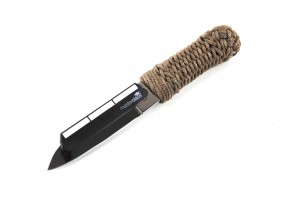
Fixed onto the back of the blade, this clever little guide rail positions the knife on the steel (or stone) at the perfect angle for the most accurate and efficient sweep of the blade.
It features a ceramic protective strip for durable use and, in terms of value for money, we think it’s the most useful bit of kit here. It fits most knives, and if you use it every time, you’ll prolong the life of your knife immeasurably. £4.99, www.amazon.co.uk click: HERE
PORTABLE WHETSTONE
A great piece of kit we’ve been using for a year or so is the DC4 fine diamond stone from Swedish specialists Fallkniven. The little 10 cm stone is two sided with a 25 micron gold-coloured honing diamond stone and a special ceramic stone, made of synthetic sapphires for polishing and finishing. These materials are chosen to stay flat through use so they maintain the right profile for sharpening a sheath knife. We find it very handy – it does not need oil or water and comes in a protective leather sheath – so it sits in the sailing grip without smudging carborundum all over your best go ashore ducks.
A tip for using this stone is to hold it down on a flat surface while you draw the knife across it away from you. It is small and thin in the fingers though and a good idea is to cut a 10cm notch in block of wood which would hold it steady while using its surface fully. £17.99 on Amazon: HERE
ROCKINGHAM FORGE CORUNDUM CERAMIC STEEL

Corundum is the hardest form of ceramic, making sharpening knives easier and quicker, whilst taking as little metal off the blade as possible. For true enthusiasts and perfectionists. From £19.98 inc P&P on ebay.co.uk
VICTORINOX OVAL DIAMOND STEEL
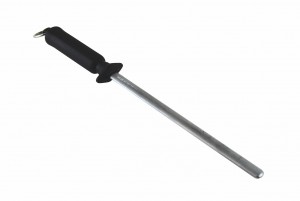
This 26cm steel boasts a coating with up to two million synthetic diamond particles. Regular swiping with one of these, (and do use a guide rail until you get used to the angle) ensures the edge needs little else and will last a long time, as it uses such minute particles it’s almost like honing. From £20 plus P&P www.markus-heucher.de


